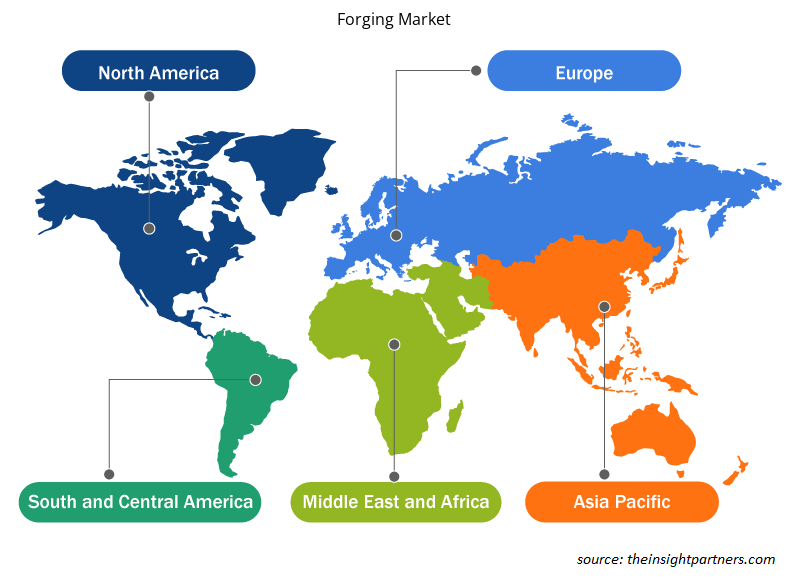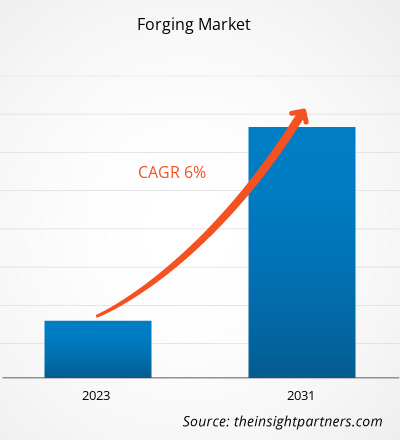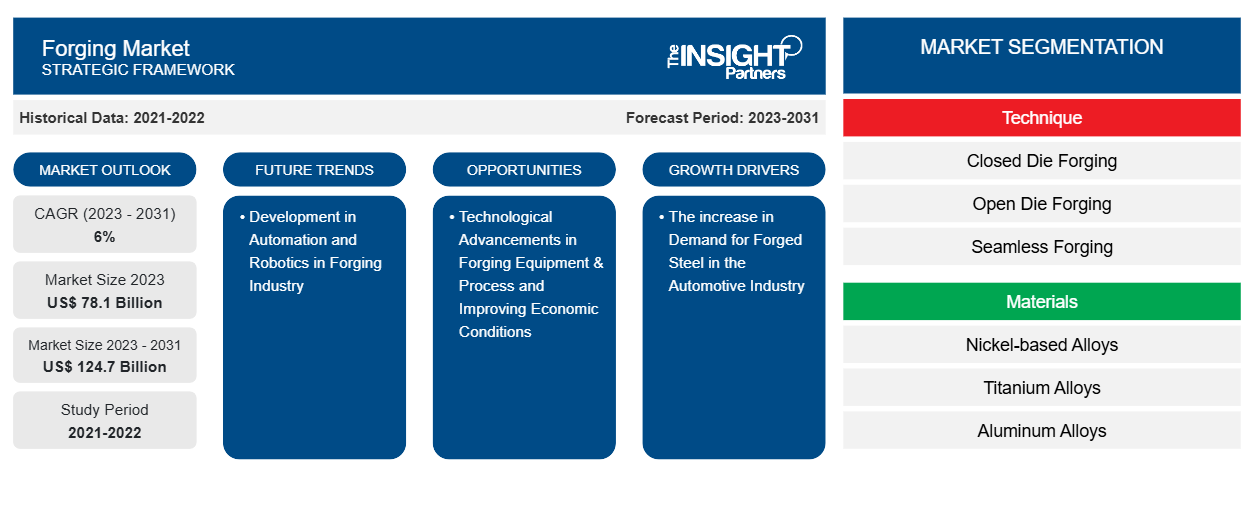锻造市场规模预计将从 2023 年的 781 亿美元增至 2031 年的 1247 亿美元。预计 2023-2031 年期间市场复合年增长率将达到 6%。可再生能源发电投资增加以及航空航天、汽车和建筑行业需求增加是推动锻造市场发展的几个因素。
锻造市场分析
由于汽车和航空航天工业的需求不断增长,全球锻造市场正在温和增长。航空客运量的增加导致航空航天部门的扩张,从而推动了锻造航空航天部件的制造。此外,全球各国政府都在加大对风能项目的投资,这导致对风能锻造部件的需求激增。然而,廉价替代品的可用性和高成本在一定程度上抑制了锻造市场的扩张。
锻造市场概况
随着人口增长和工业化进程的加快,全球对能源的需求不断上升。能源消耗的增加推动了对发电厂和基础设施建设的投资需求,进一步推动了对配件、法兰、阀门、螺柱、容器和螺母等锻造部件的需求。锻造行业通过生产具有难以复制的独特优势的部件,在全球工业经济中占据了重要地位。锻造部件的强度、可靠性和耐用性使其成为各种工业应用的首选,在这些应用中,疲劳寿命和断裂韧性对人员和设备的安全至关重要。
定制此报告以满足您的需求
您可以免费定制任何报告,包括本报告的部分内容、国家级分析、Excel 数据包,以及为初创企业和大学提供优惠和折扣
-
获取此报告的关键市场趋势。这个免费样品将包括数据分析,从市场趋势到估计和预测。
打造市场驱动力和机遇
汽车行业对锻钢的需求不断增加
钢锻件的耐用性、可靠性和强度使其成为汽车行业的首选。不锈钢、合金和碳钢是汽车工业中广泛使用的钢材类型,用于生产连杆、控制臂、摇臂、曲轴、凸轮轴、拉杆端和转向节等各种部件。钢锻造工艺可以生产出近净形状的汽车零件,无需通过闭模方法进一步加工,从而节省了金钱和时间。此外,闭模锻造方法可用于定制由钢合金制成的各种汽车部件,例如 ASTM4140 钢和 AISI 1045 钢。闭模钢锻造技术主要用于制造各种商用车和乘用车的汽车零件以及电动汽车 (EV) 的轻型钢锻件。因此,锻钢在汽车工业中的使用日益增多,推动了锻造市场的发展。
改善经济条件和锻造设备及工艺技术进步
在快速发展的行业中,对复杂和创新锻造产品的需求正在上升。自动化闭模锻造工艺引起了设备供应商对开发新型锻造设备和锻造工艺的关注。在商业航空航天应用中,这些新型锻造机能够锻造超大型镍基和钛基合金零件。目前,行业自动化对闭模锻造市场的增长产生了中等程度的积极影响,但预计在预测期内将有所增加。
在这个市场中运营的公司致力于提供精益、有弹性、灵活且适应性强的锻造工艺,以维持金属成型市场日益激烈的竞争。此外,在印度和中国等国家,石油和天然气、造船、汽车、发电、航空航天和建筑等终端行业对闭模锻造产品的需求正在显著增长。因此,在预测期内,经济状况的改善和锻造技术的不断创新预计将为锻造市场提供机会。
锻造市场报告细分分析
有助于得出锻造市场分析的关键部分是技术、材料和行业。
- 根据技术,锻造市场分为闭式模锻、开式模锻和无缝锻造。闭式模锻部分在 2023 年占据了最大的市场份额。
- 根据材料,锻造市场分为镍基合金、钛合金、铝合金、钢合金等。钢合金部分在 2023 年占据了最大的市场份额。
- 按行业划分,市场分为汽车、航空航天、铁路、重型设备和风力发电。汽车行业在 2023 年占据了市场主导地位。
锻造市场份额按地区分析
锻造市场报告的地理范围主要分为五个区域:北美、欧洲、亚太、中东和非洲、南美和中美。
2023 年,亚太地区占据锻造市场主导地位。亚太锻造市场分为澳大利亚、中国、日本、印度、韩国和亚太其他地区。铁路、建筑、发电、航空航天和汽车等应用领域对金属锻造部件的需求不断增长,预计将在预测期内推动锻造市场的增长。中国是亚太地区金属锻件的主要消费国和制造商。中国向美国和欧洲国家出口大量锻造产品。中国各种协会致力于锻造工艺的发展,这是锻造市场增长的主要因素之一。此外,由于市场和政府的压力,中国锻造行业正努力生产精度更高、效率更高、数字化更普及、重量更轻、能耗更低的锻件。最近,在锻造机械研发和制造、仿真应用、IT 应用,尤其是精密锻造方面取得了许多优异的成就。
打造市场区域洞察
Insight Partners 的分析师已详细解释了预测期内影响锻造市场的区域趋势和因素。本节还讨论了北美、欧洲、亚太地区、中东和非洲以及南美和中美洲的锻造市场细分和地理位置。

- 获取锻造市场的区域具体数据
锻造市场报告范围
| 报告属性 | 细节 |
|---|---|
| 2023 年的市场规模 | 781亿美元 |
| 2031 年市场规模 | 1247亿美元 |
| 全球复合年增长率(2023 - 2031) | 6% |
| 史料 | 2021-2022 |
| 预测期 | 2023-2031 |
| 涵盖的领域 |
按技术分类
|
| 覆盖地区和国家 |
北美
|
| 市场领导者和主要公司简介 |
|
打造市场参与者密度:了解其对商业动态的影响
锻造市场正在快速增长,这得益于最终用户需求的不断增长,而这些需求又源于消费者偏好的不断变化、技术进步以及对产品优势的认识不断提高等因素。随着需求的增加,企业正在扩大其产品范围,进行创新以满足消费者的需求,并利用新兴趋势,从而进一步推动市场增长。
市场参与者密度是指在特定市场或行业内运营的企业或公司的分布情况。它表明在给定市场空间中,相对于其规模或总市场价值,有多少竞争对手(市场参与者)存在。
在锻造市场运营的主要公司有:
- 美国铝业公司
- 全金属锻造集团
- 中孚机械有限公司
- 菲赛普公司
- 巴拉特锻造有限公司
- 阿勒格尼技术公司
免责声明:上面列出的公司没有按照任何特定顺序排列。

- 了解锻造市场顶级关键参与者概况
锻造市场新闻及最新发展
锻造市场通过收集一手和二手研究后的定性和定量数据进行评估,其中包括重要的公司出版物、协会数据和数据库。下面列出了锻造市场的一些发展情况:
- 2024年4月,Ramkrishna Forgings与美国最大的乘用电动车制造商签署了供应协议。通过这笔交易,该公司将供应动力总成零部件,并首次成为美国电动车市场的供应商。
- 2024 年 2 月,US Forged Rings 宣布向海上风电行业投资 7 亿美元,用于建设塔架制造厂和钢锻造厂。通过这一发展,该公司将巩固其在市场上的地位。
打造市场报告覆盖范围和交付成果
“锻造市场规模和预测(2021-2031)”报告对以下领域进行了详细的市场分析:
- 针对范围内的所有关键细分市场,制定全球、区域和国家层面的市场规模和预测
- 塑造市场趋势以及市场动态,如驱动因素、限制因素和关键机遇
- 详细的 PEST/波特五力分析和 SWOT 分析
- 锻造市场分析涵盖主要市场趋势、全球和区域框架、主要参与者、法规和最新市场发展
- 行业格局和竞争分析,涵盖市场集中度、热点图分析、知名参与者以及锻造市场的最新发展
- 详细的公司简介
- 历史分析(2 年)、基准年、预测(7 年)及复合年增长率
- PEST和SWOT分析
- 市场规模、价值/数量 - 全球、区域、国家
- 行业和竞争格局
- Excel 数据集
近期报告
客户评价
购买理由
- 明智的决策
- 了解市场动态
- 竞争分析
- 客户洞察
- 市场预测
- 风险规避
- 战略规划
- 投资论证
- 识别新兴市场
- 优化营销策略
- 提升运营效率
- 顺应监管趋势























 获取免费样品 - 锻造市场
获取免费样品 - 锻造市场